My Telescopes
Here's a list of the telescopes I've owned...
I got my first telescope during the Christmas of 1979. It was a spindly little 40mm reflector from Sears and it came with just one eyepiece. It’s wobbly little wooden legs and plastic mount could barely keep the optical tube steady long enough to get a decent peek, but I managed to use that scope to explore the wonderfully cratered surface of the Moon, to see the moons of Jupiter and bask in the splendour of the rings of Saturn. That scope opened the world of astronomy to me.
Telescopes
I have had a vast variety of telescopes over the 40 years I’ve been observing, but I currently have just two scopes that I use nowadays. My “big” scope is an 8-inch Schmidt Cassegrain from Meade and my portable “grab and go” scope is a 70mm achromatic refractor from Sky-Watcher. I tend to use the bigger scope more often because aperture tends to rule the day, all other things being equal. Think of a telescope like a bucket and the light from the cosmos is like rain drops. The bigger around your bucket is, the more rain drops you can catch at once. So, the bigger around (aperture) the telescope is, the more photons it can catch at once and the brighter the image will be at the eyepiece. This helps in picking out various details of an object whether it is the ovals and festoons on the clouds of Jupiter, resolving stars in the great cluster M13 in Hercules or seeing the spiral structure of the Whirlpool Galaxy M51. My little scope can see Jupiter, M13 and M51, but I can’t see anywhere near the same level of detail through it - simply due to the much smaller aperture (70mm vs. 203mm).
Both of my telescopes are mounted on German Equatorial Mounts (or GEMs). This type of mount has two axis that allow the scope to move side to side and up and down. The twist is that one of the axis is pointed at the north star (Polaris), so that when a motor is turned on in the mount (called the Right Ascension Motor), the telescope will actually “track” the object I’m looking at. That means I can get Jupiter lined up in my eyepiece and it will stay there for hours if I want it to. The motor is actually counter-acting the rotation of the Earth in order to keep the object in my field of view. This is very handy for doing extended observations on objects.
My main scope - a Meade 2080 LX6 Premier: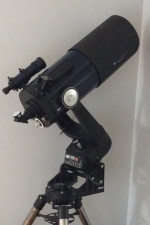 |
My portable scope - a Sky-Watcher 70mm refractor: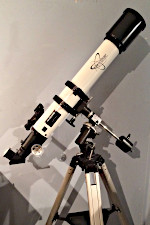 |
Eyepieces
All telescopes take the light they gather and focus it in a small area called the focal plane. The telescope itself does not magnify the image - it just provides the raw data and the eyepiece that you put in the focuser of the telescope magnifies the image and provides the presentation that your eye consumes. Eyepieces vary greatly in price and quality - the cheapest eyepieces will still provide an image, but it could potentially be very difficult to focus and could distort the image so much that details would be impossible to discern. I prefer higher quality eyepieces that provide a crisp, clear image of the object I’m looking at - but at the same time, I am a bit old fashioned and prefer light weight, simple eyepiece designs. Therefore, what I use is mostly Plössl eyepieces from Tele Vue Optics which although patented in the early 1980’s by Tele Vue, the design originates in the mid 1800’s. Similarly, my highest power eyepiece is an Abbe Orthoscopic design - modern in coatings and manufacture, but the design also originates in the mid 1800’s. None of these eyepieces are terribly expensive (approx $100 each) but they all provide a beautiful, clear image of the target I am observing.
My eyepiece set: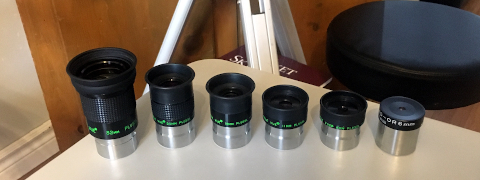
(Left to right: Tele Vue 32mm, 20mm,
15mm,
11mm and 8mm Plössls, Fuyiyama 6mm Ortho)
Past Scopes:
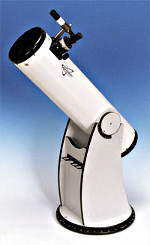 NewStar 8-inch
Dob:
NewStar 8-inch
Dob:
I found this treasure in a recycle store for only $75! It was one of those situations
where I picked it up and starting yelling at my wife to start the car! The scope came with no eyepieces, but
the primary and secondary mirrors are in mint condition, and overall the scope is in good shape. It looks like
it is a Guan Sheng sourced scope and provides nice, sharp images. I decided to give it to my daughter Jen as
she is also into astronomy!
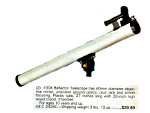 Sears 100
Power
Reflector (24261) (1979 - 1994):
Sears 100
Power
Reflector (24261) (1979 - 1994):
I got this scope for Christmas in 1979. It was a
small reflector with a 40mm mirror. It had a very long, slender tube that was mounted on a wooden-legged
tripod. It came with two eyepieces; a 4mm and a 12mm. Both were Ramsden eyepieces with plastic optics. One
thing I recall from this scope is that the secondary mirror was actually rectangular! It was little more than
a bent piece of plastic with a reflective coating on one side. The views of the Moon were dim, but
fascinating! I also recall seeing Jupiter through this scope. I was unable to center it on any stars or other
planets. The finder scope on this unit was just a hollow tube of plastic (zero power!). It sparked my interest
in astronomy, and I kept it until 1994 when I got my second scope.
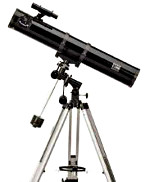 Bausch & Lomb Professional 200 (1994 - 1996):
Bausch & Lomb Professional 200 (1994 - 1996):
This was my first "real"
telescope which I got in 1994. At that time, I was just married, and my wife and I were living in an apartment
in Toronto. A friend of mine at Microsoft (where we both worked) loaned me his Meade 4400 telescope, which was
a 4.5 inch reflector on an EQ-2 mount. It was wonderful to use and showed brilliant views of the Moon,
Jupiter, Saturn, Mars and Venus. Also M13 and M31 were viewed. I liked it so much I bought my own, in this
case a B&L Pro 200, which was very similar. It came with two eyepieces; a 10mm and 25mm Kellners. I used
this scope to view the comets Hale Bopp and Hyakutake which were two fabulous comets from the mid-1990's.
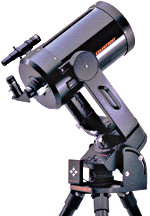 Celstron
Celestar
8 (1996 - 2000):
Celstron
Celestar
8 (1996 - 2000):
Shortly after getting my previous scope (a 4.5in Newt), aperture
fever struck and I was eager to convince my wife to let me upgrade to something more powerful. I rented an old
orange-tube Celestron C8 from a local retailer and loved every minute of it. The fork-mounted setup allowed me
to "point and look" with ease. I returned it and bought a brand new Celestron Celestar 8 from them. It came
with a 25mm SMA eyepiece (which is similar to a Kellner), and I added a Telrad and a Tele Vue 20mm Plossl
(which provided stunning views!). The unique wedge-pod design provided a handy storage area or eyepieces and
barlows, and the electronic clock drive ran off one solitary 9V battery! This was my main scope for many
years.
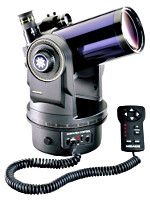 Meade
ETX
90/EC (2000 - 2001):
Meade
ETX
90/EC (2000 - 2001):
This was my first Maksutov-Cassegrain telescope, and also my
first foray into the world of GOTO controllers. When I first set it up in my living room (per the instruction
manual), it started slewing towards the floor when I asked it to do a 3-star alignment. The unit was seriously
confused about what was going on! An upgrade to the AutoStar software through my computer fixed the issue, and
the ETX provided me years of enjoyment. I even had a chance one summer to compare it directly to the Questar
3.5 Standard (which is a scope that costs 7 times as much but is essentially the same design and size) and the
ETX held it's own with no issues.
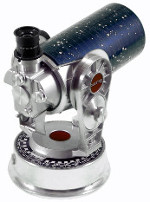 Questar 3.5 Standard (2001 - 2001):
Questar 3.5 Standard (2001 - 2001):
During one lucky summer for me, a close
friend of mine informed me he had a Questar 3.5 Standard telescope that he had inherited. He knew nothing
about telescopes or astronomy, but knew it was my passion. He very kindly loaned me the scope for an entire
summer so I could use and enjoy it, as well as compare it to my Meade ETX 90/EC - which was a very similar
(albeit much less expensive) telescope. The Questar's engineering was simply a joy to behold and use. The
built-in finder function that uses the current eyepiece was sheer genius. The all metal fork mount was a
pillar of stability compared to my Meade's plastic layout. Overall I really enjoyed the Questar - although
where it counts (at the eyepiece), there wasn't much to choose between the mighty Q and my ETX.
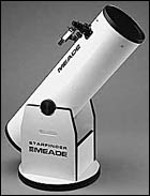 Meade
Starfinder 10 (2001 - 2002):
Meade
Starfinder 10 (2001 - 2002):
This was my first scope over 8 inches in aperture. The
quality of the Meade optics was a step above (at the time) the imported competitors, so I spent the extra
cash. It came with a Series 4000 26mm Super Plossl eyepiece and provided beautiful, bright views of deep sky
objects. The Hercules Cluster (M13) was awesome through this scope, showing tons of individual stars, and a
very granular, mottled core. I would throw this scope into my car and haul it all over creation! It was a
fantastic companion, and it is the only scope that I've attempted a Messier Marathon with!
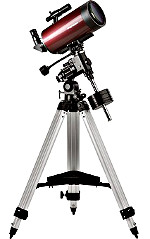 Orion
StarMax 127 (2002 - 2003):
Orion
StarMax 127 (2002 - 2003):
This tank of a scope was a lot of fun! I bought this when
I decided to downsize from my 10-inch Dob, which was beginning to be a pain in the back to cart around. The
StarMax provided tack sharp views of the stars, although it's long focal length meant that wide field viewing
was no longer really an option (the narrow passage in the primary mirror meant that only 1.25 inch occulars
could be used, effectively making my widest view through a 32mm Plossl). Overall I enjoyed this scope a lot, I
loved the build quality and there's something about a Maksutov meniscus corrector that just looks so good!
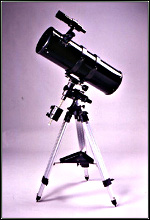 Guan
Sheng
GS-600 (2003 - 2003):
Guan
Sheng
GS-600 (2003 - 2003):
In the summer of 2003, Mars was at perihelion and also at
opposition, so it was as big as it was going to get for a long, long time. I only had a 5-inch scope then
(Orion StarMax 127), and I wanted more aperture to take advantage of this situation. So, I picked up the
GS-600 which is an 8-inch F/4 telescope on a EQ-3 mount. I painted it green and took it outside! I thoroughly
enjoyed the Mars opposition and spent many evenings under the stars with this scope. I maybe should have held
on to it, as at F/4, it would have made a terrific astrograph! Oh well.
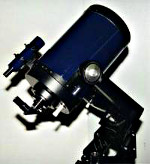 Meade 2120
LX-6
Premier (2003 - 2005):
Meade 2120
LX-6
Premier (2003 - 2005):
This is probably my favourite scope that I have ever owned.
It is the one that I regret selling. Originally purchased from a good friend (thanks Augie!), this scope came
with the Meade Super-Wedge, an LX-6 Quartz-controlled computer, and a heavy-duty field tripod. The entire
setup was massive. I also had the Meade dew shield, and a Telrad mounted to the OTA. At one point, I had a
Panasonic brick computer (Toughbook CF-07) that fit perfectly in the wedge below the OTA. I could run
astronomy software (Starry Night Pro, Cartes Du Ciel) and navigate my way through the heavens. The LX-6
controller had a RA and Dec digital display (so this scope was PUSH-TO instead of GOTO) and tracked flawlessly
and silently!
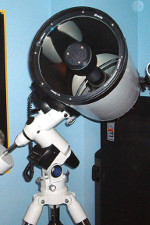 Meade
LXD-75
SC-10 AT (2005 - 2010):
Meade
LXD-75
SC-10 AT (2005 - 2010):
A few years after buying the Meade 2120, I upgraded the
mount to Meade's LXD-75 GOTO AutoStar mount. Meade never offered a 10-inch SCT OTA with this mount, as it was
right on the edge of the LXD-75's payload rating. That didn't slow me down! I took the OTA off the LX-6 mount,
painted it white, and attached a dovetail bar to it! Instantly, I had a large-aperture GOTO scope that was
just totally awesome! I had to ensure that the OTA was counter balanced and centered properly to avoid gear
lash and grinding. But when things were set up correctly, this scope worked perfectly! I really miss the old
girl...! Note: I found an image of my old setup on an ancient forum post!!! I love the Internet!
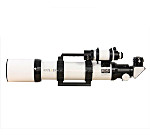 Explore Scientific ED-102 (2010 - 2016):
Explore Scientific ED-102 (2010 - 2016):
This is an apochromatic air spaced
triplet with an f/7 focal ratio. The workmanship on this scope is excellent, and it's two speed Crayford
focuser allows for super sharp images. I bought a SkyWatcher EQ-5 mount as well as the right ascension and
declination gear motors with a simple control box. This is not a GOTO setup, but it will track an object once
it is centered in the field of view. I am amazed at the contrast and sharpness from the 4-inch optics. Don't
get me wrong, my 8-inch Dob provides much brighter views, but 90% of the time, I prefer the views through my
APO!
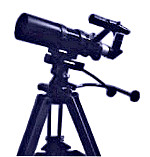 Vista
508SE:
Vista
508SE:
I bought this little refractor (80mm f/5) which was identical to the venerable Orion
Short Tube 80. A review I wrote in 2002:
Nice wide field views. Can't handle much power (dies at around 80x), but images are crisp. False colour is quite annoying on very bright objects like the Moon and Jupiter. M13 shows granularity, but no stars are resolved. Great little grab and go scope, if you can get one on an EQ mount, it's really worth the money. Build quality is so-so, but the focuser is really smooth. VERDICT - Recommended.
 NewStar
70mm
f/10:
NewStar
70mm
f/10:
I picked up just the OTA for this scope at a local retailer at a good discount. I then
picked up an EQ-2 mount to set it upon. A little body work in my garage changed the holes around from an
alt-az setup to an eq one. I painted the tube light blue (and gave it the nickname the "Blue Noodle") and it
was off to the races! It was a great travel scope, and it took power a little more readily than the Orion
Short Tube 80 would. However, at anything over 100x, the chromatic aberration was quite pronounced. Overall it
was a fun little scope to own... kind of thought of it as my slightly longer, slightly less good Tele Vue
Proto! LOL!
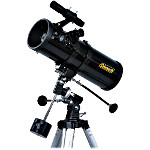 Coleman AstroWatch 114 EQ:
Coleman AstroWatch 114 EQ:
This was my daughter's first scope, and unfortunately it
didn't last long. It is a Skywatcher 114 clone, but the EQ-1 mount is terrible: it has the shakes, the slow
motion controls don't work, and the axis locks don't work. The optics don't hold collimation at all, and the
eyepieces are 3 element jobs that are okay, but certainly nothing special. Overall it is a junk telescope
despite the specs. Perhaps the actual Skywatcher version is much better, but I can certainly see why Coleman
was selling these off.
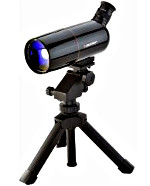 Celestron
C65:
Celestron
C65:
When I saw this scope, I thought it would make the perfect mini grab and go scope.
Maksutov optics? I love them! Tiny alt-az tripod with slow-motion controls? Perfect! Built in zoom eyepiece?
Excellent! The truth is this is a total piece of junk - absolutely useless as an astronomical instrument. I
couldn't even hack-saw it apart to make it more useful (by adding a proper focuser and putting it on a better
mount). It was a total waste of money, but in the end it wound up being a decoration in my office. I still
liked looking at that meniscus corrector! Awesome! LOL!
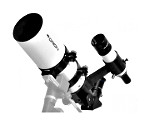 Orion
80mm
F/5:
Orion
80mm
F/5:
This was my "grab n go" scope. I had one previously (the Vista 508SE) and I always
regetted getting rid of it. So, I snapped up this Orion when I had the chance. I had it mounted to small
portable EQ-2 mount which was rock steady. I recall using my Orion Edge-On Planetary 5mm eyepiece with this
scope to look at Saturn and the view really knocked my socks off! This provided 80x of power, which is the
upper reach of this little scope. The optics are quite good on this one! It was replaced by a 70mm f/10 scope.
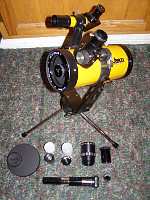 Jason
Comet Chaser 480:
Jason
Comet Chaser 480:
This little desktop scope was bought from a friend of mine (thanks Dave!)
so that I could have something cool to stare at while programming at work. I love the tiny "corrector" plate
at the front, and the cool construction- bulldozer orange paint. I had the little guy out the other night and
the images of Jupiter weren't too bad through the 20mm Kellner eyepiece. I popped in a 4mm Ramsden eyepiece,
and the view was terrible. That's what you get for trying to use an eyepiece with plastic lenses (no fault of
the telescope for the horrible image)! I now have a 6mm Ortho, a 9mm König and a 12.5mm Huygens to go
along with the decent 20mm Kellner.